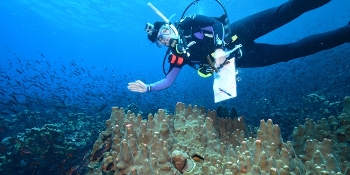Jul 12 2013
By the time a coral that has been exposed to oil shows signs of sickness it may already be close to death. That's why Iliana Baums, assistant professor of biology at Penn State, is investigating the use of molecular tools to detect signs of stress in corals before they become ill and also to determine just how much oil is lethal to corals.
 Iliana Baums collects samples of Porites corals in the Pacific Ocean. (Image: Joshua Feingold, Nova Southeastern University)
Iliana Baums collects samples of Porites corals in the Pacific Ocean. (Image: Joshua Feingold, Nova Southeastern University)
"Our goal is to understand how deep-sea corals react to oil and dispersant exposure so that ecosystem managers can be better prepared to respond during and after oil spills," said Baums, who is using funds from a grant she and Charles Fisher, Penn State professor of biology, recently received from BP's $500-million Gulf of Mexico Research Initiative to do the work.
"The surface of corals' thin tissue layer is covered in mucus, in a way that is similar to the mucus lining of our body cavities," said Baums. "Just like us, this lining contains a great number and diversity of bacteria. When the environment changes, for example by adding a lot of oil to the water, so will the bacterial community in the mucus, thus providing us with something we can observe in corals exposed to oil."
Baums plans to grow live corals in aquaria in her laboratory, expose them to different quantities of oil and dispersant, and monitor which genes get switched on, which proteins are made, and how the bacteria change in the mucus layer. She will compare the results to those of animals sampled in situ in the Gulf of Mexico that were not affected by the oil spill.
"This data will help us understand how oil spills and the dispersants used to clean up those spills affect corals who build the three-dimensional structure of deep and shallow water reefs," Baums says.
Iliana Baums is assistant professor of biology, [email protected].